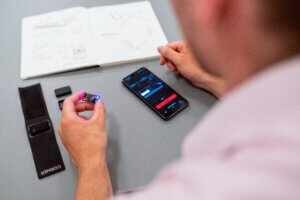After reading this article, you’ll:
- Understand the crucial role that wireframing and prototyping play in the development of healthcare apps, especially in enhancing functionality, improving user experience, and ensuring patient safety.
- Gain insights into why involving stakeholders, healthcare professionals, and end-users in the prototyping stage can provide invaluable feedback, thereby reducing risks and costs while speeding up the development cycle.
- Learn about the different types of prototyping and wireframing techniques, and how to choose the most suitable method based on project scope, timeline, and budget, to create a robust, user-friendly, and compliant healthcare app.

In an era marked by rapid technological advancements, healthcare is a sector that has received transformative digital inputs, from Electronic Health Records to telemedicine platforms. The integration of technology within healthcare aims to make medical services more efficient, accessible, and patient-centric. However, the stakes in developing healthcare apps are extraordinarily high: even the smallest error can result in potentially life-threatening consequences. In this high-pressure environment, how do developers ensure that their healthcare apps are not only functional but also user-friendly and error-free?
Enter wireframing and prototyping—two crucial stages in the app development process that can make or break the user experience. While these terms may evoke images of architectural drafts or engineering blueprints, their implications for healthcare app development are profound. They serve as the essential building blocks for designing an intuitive, secure, and robust application that healthcare providers and patients can rely on.
This article aims to illuminate the vital role that wireframing and prototyping play in healthcare app development, discussing their impact on user experience, functionality, and ultimately, patient care. Whether you are a developer, a healthcare provider, or an entrepreneur looking to venture into the world of healthcare technology, understanding the importance of these steps will provide you with a roadmap to create applications that not only perform well but also save lives.
What is Prototyping?
 Prototyping is the process of creating a preliminary model of the final product, in this case, a healthcare app. Unlike wireframes that offer a static outline, a prototype is interactive, simulating user interface interaction. It enables developers to test functionalities and design elements in a realistic environment. By giving both the development team and stakeholders a tangible or visual representation of the app’s design and functionalities, prototyping helps to pinpoint potential issues and areas for improvement early in the development process. It is a crucial step that bridges the gap between conceptualization and implementation.
Prototyping is the process of creating a preliminary model of the final product, in this case, a healthcare app. Unlike wireframes that offer a static outline, a prototype is interactive, simulating user interface interaction. It enables developers to test functionalities and design elements in a realistic environment. By giving both the development team and stakeholders a tangible or visual representation of the app’s design and functionalities, prototyping helps to pinpoint potential issues and areas for improvement early in the development process. It is a crucial step that bridges the gap between conceptualization and implementation.
Why is Prototyping Important?
The importance of prototyping in healthcare app development cannot be overstated. This stage allows for a series of critical evaluations and refinements that significantly contribute to the end product’s success. Here are some reasons why prototyping is an indispensable step:
Better Understanding From Developers
The prototyping phase provides developers with an opportunity to deeply immerse themselves in the nuances of the healthcare app. It’s one thing to conceptualize an idea and another to interact with it. Prototyping allows the development team to scrutinize the initial assumptions against real-world interactions.
This critical evaluation prompts questions and sparks discussions that might not have been possible with a mere conceptual framework. This is where the team can identify gaps, test different solutions, and thereby minimize the chance of delivering a flawed product. In the healthcare sector, where mistakes can cost lives, the value of this clarity and understanding can be immeasurable.
Concrete Feedback From Users and Stakeholders
Prototypes serve as an early-stage product that can be shown to users for firsthand feedback. This feedback is invaluable as users often use the product in unforeseen ways or may require features that were initially overlooked. In the healthcare industry, this means nurses, doctors, administrators, and patients can interact with the app and provide actionable insights that go beyond generic use-cases. They can point out if a function is taking too many steps to complete, or if the app is missing a vital feature necessary for clinical operations, thereby ensuring that the app not only meets but exceeds the needs of its users.
Cost Savings
From a financial standpoint, the prototyping stage acts as a cost-saving mechanism. It’s much more efficient to correct issues when they are still in the design phase rather than after the app has been coded, launched, or even worse, used in a healthcare setting. Changes in the later stages of development often necessitate going back multiple steps, requiring more time and resources. By discovering and tackling issues early, the project can avoid cost overruns and stay within budget, an especially important consideration for healthcare organizations operating under financial constraints.
Faster Buy-In
The decision-making process in healthcare can be filled with bureaucratic delays. Prototyping can accelerate this process by offering stakeholders a tangible or semi-functional version of the app. They don’t have to rely solely on descriptions or concept art. They can interact with the prototype, visualize its utility, and consequently understand its impact on healthcare delivery. This often translates to faster approvals, more enthusiastic support, and quicker mobilization of resources, thereby speeding up the entire development cycle.
Risk Mitigation
In an industry where the margin for error is thin, risk mitigation is not just a best practice but a necessity. Prototyping allows for thorough testing of functionalities, security features, and user interactions. This process can uncover vulnerabilities or potential failure points that, if not addressed, could result in critical errors or security breaches.
In the context of healthcare, these risks can involve the mishandling of sensitive patient data or the incorrect execution of clinical tasks, both of which have significant legal and ethical ramifications. Prototyping serves as an early-warning system, enabling the team to rectify issues well before they escalate into serious problems, thereby ensuring user safety and organizational compliance.
Types of Prototyping
 In healthcare app development, there are various types of prototyping techniques to consider, each with its unique advantages and limitations. Some common methods include:
In healthcare app development, there are various types of prototyping techniques to consider, each with its unique advantages and limitations. Some common methods include:
- Paper Prototyping: The most basic form, involving sketches or printouts, useful for conceptualizing basic interface layouts.
- Click-through Prototypes: These are digital but primarily non-interactive, allowing for basic user flow visualization.
- Interactive Prototypes: High-fidelity prototypes that simulate most functionalities and interactions within the app, providing a near-authentic user experience.
- Functional Prototypes: These are coded prototypes with limited functional backend features to simulate data transactions and other key operations.
The choice of prototyping method may depend on various factors such as project scope, timeline, budget, and the complexity of the healthcare app. Often, a combination of these types can be employed at different development stages for best results.
Which Parts of the Healthcare Digital App Experience Need Prototyping?
When developing a healthcare app, almost every aspect can benefit from prototyping, but some key areas require special attention:
- User Interface (UI): The design and layout, ensuring that the app is intuitive and user-friendly, especially for healthcare professionals who may need quick access to vital information.
- User Experience (UX): The overall feel of the app, including ease of navigation and user flow, which is critical for both healthcare providers and patients.
- Data Input and Retrieval: Prototyping is essential for testing how effectively the app handles data input, storage, and retrieval, especially with regard to electronic health records (EHR).
- Security Features: Due to the sensitive nature of healthcare data, prototyping should also involve testing the app’s security measures such as data encryption and user authentication.
- Interoperability: In healthcare settings, an app often needs to communicate with other software and hardware; prototyping ensures that this interoperability is functional and seamless.
- Compliance: Healthcare apps must adhere to regulatory standards like HIPAA in the U.S., and prototyping can help in ensuring these compliances are met right from the development stage.
By prototyping these integral components, developers can create a healthcare app that is not only robust and user-friendly but also safe and compliant with legal requirements.
What is Wireframing?
Wireframing is the practice of creating a visual skeleton or blueprint of an application’s interface, aimed at illustrating its structure, layout, and functionality. Unlike prototypes, wireframes are generally static and focus on what the interface does rather than how it appears or feels. In healthcare app development, wireframes serve as the foundational guide for all stakeholders, delineating how users will interact with the app and where key features will reside.
Why are Wireframes Important?
Wireframes play a vital role in the app development process for several reasons. They help in planning, visualizing the user journey, testing visual elements, and facilitating communication among project teams.
Clear Vision of Every Planning and Development Step
Wireframes act as a roadmap for the entire development process. They help in outlining the architecture of the app, setting the stage for each developmental phase, and ensuring that nothing crucial is overlooked. In healthcare app development, where precise data handling and user interactions can make a difference in patient outcomes, a clear plan is invaluable.
Better Understanding About The User Journey
Understanding the user journey is crucial, especially in healthcare, where ease of use can directly impact the quality of care. Wireframes allow the team to plot the various steps a user will take, from login to accessing specific health information, thereby highlighting bottlenecks or pain points that may require attention. These scenarios can be mapped out in detail, showing how users would navigate through different features like appointment scheduling, accessing lab results, or conducting virtual consultations. This in-depth understanding of the user journey aids in designing a more intuitive and efficient app.
Testing Visual Branding Elements
While wireframes are primarily for understanding functionality and layout, they can also serve as a preliminary canvas for visual design elements such as color schemes, logos, and typography. This helps in aligning the app’s visual branding with the overarching brand identity of the healthcare institution or service, ensuring a cohesive user experience.
Streamlining Communication Among Teams
Wireframes function as a universal language that streamlines communication across different departments involved in the project—be it developers, designers, project managers, or healthcare experts. They ensure everyone is on the same page regarding the app’s structure and functionalities. This is particularly useful in healthcare settings, where a multidisciplinary approach is often required to address the complexities of medical care and data management.
By offering a tangible reference point, wireframes mitigate misunderstandings and fast-track decision-making processes, thereby accelerating the overall development timeline.
How to Effectively Use Prototyping and Wireframing in Healthcare App Development
To maximize the benefits of prototyping and wireframing in healthcare app development, a strategic approach is essential. First, start with low-fidelity wireframes to outline basic structures and features. Progress to high-fidelity prototypes to simulate interactions and fine-tune the user experience. At each stage, involve stakeholders, healthcare professionals, and end-users for feedback.
Use specialized software tools for wireframing and prototyping to enhance precision and save time. Establish a strong feedback loop and iterative process for continuous refinement. This multi-faceted approach ensures that the app is user-centric, compliant with healthcare regulations, and fine-tuned for optimum performance.
Use of Tools
There are numerous tools available for wireframing and prototyping, ranging from basic sketching software to more complex, interactive platforms. Selecting the right tool is essential for creating accurate, functional models. In healthcare app development, opt for tools that allow for secure collaboration, as sensitive data or regulatory guidelines may be discussed.
Feedback Loops
Establishing a robust feedback loop is crucial for the success of healthcare apps. This involves iterative testing and refinements based on user and stakeholder feedback. It’s especially important to involve healthcare professionals who can provide insights into clinical needs and regulatory compliance. The faster the feedback is incorporated, the more agile the development process becomes, allowing for a quicker time-to-market and a more polished end product.
By prioritizing wireframing and prototyping, healthcare organizations can ensure that their apps stand up to the twin tests of user experience and clinical effectiveness. In doing so, they not only enhance the efficacy of the care provided but also contribute to a more streamlined and efficient healthcare system. At the end of the day, a well-designed app can serve as a powerful tool for enabling better patient outcomes, and that is a goal we can all strive towards.
So, whether you’re in the brainstorming phase or deeply embedded in coding, don’t underestimate the importance of these preparatory steps. The extra time spent on wireframing and prototyping can make the difference between an app that is merely functional and one that is exceptional. And when it comes to healthcare, “exceptional” can often mean life-changing, if not life-saving.





